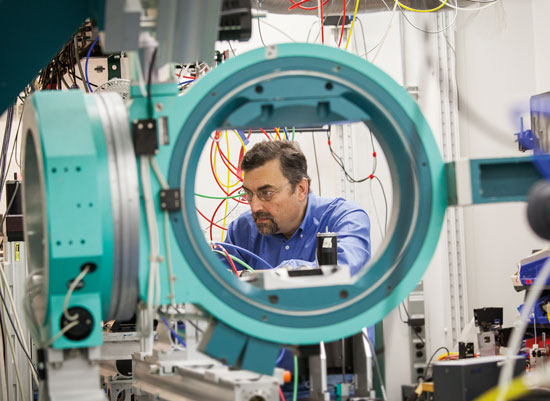Electric vehicles are dramatically changing the way people move from place to place, ushering in an era of cleaner transportation. But according to Carlo Segre, Duchossois Leadership Professor of Physics at Illinois Institute of Technology, there is still one big hitch: the distance such vehicles can travel before needing to be recharged.
Segre says that the more affordable electric vehicles today can travel approximately 100 miles on a single charge, and for some drivers, this presents what he refers to as “range anxiety”—a predicament Segre hopes to address through his research.
In a three-year, $3.4 million project funded by the United States Department of Energy Advanced Research Projects Agency-Energy (ARPA-E), Segre’s interdisciplinary team, including IIT collaborator John Katsoudas (PHYS ’97, M.S. ’04); Vijay Ramani, Hyosung S. R. Cho Endowed Chair Professor of Chemical Engineering at IIT; and collaborators from Argonne National Laboratory—Elena Timofeeva, Dileep Singh, John Zhang, and Michael Duoba (ME ’91)—will design and construct a new kind of battery for such vehicles.

Photo: Michael Goss
The range issue, Segre explains, is due to the limited energy per unit volume (or energy density) available in conventional lithium-ion (li-ion) batteries suitable for electric cars.
“If you could increase the energy density by a factor of five, you’ve got a 500-mile range,” he says. “That takes care of a lot of problems.”
The RANGE (Robust Affordable Next Generation EV-Storage) program is ARPA-E’s ambitious funding effort designed to accelerate widespread electric vehicle adoption by dramatically improving their driving range, cost, and reliability. Segre’s proposal involves the design of a prototype EV scalable flow battery that uses high-energy density nanoelectrofuel.
Li-ion batteries currently used in electric vehicles have the advantage of high cell voltage and energy density compared to previous generations of car batteries, but as Segre notes, there have always been drawbacks. In addition to energy-density limitations, there are multiple issues such as thermal runaway, gradual degradation of electrode materials, shortening the battery lifespan, and long charging times.
The group’s new approach has the potential to greatly increase the energy density and lifespan of vehicle batteries, while eliminating the need for lengthy recharging altogether. The trick, Segre explains, is in the battery fuel itself.
“Our idea and patent is to load the electrochemical fluid with nanoparticles that are solid,” says Segre. “The key is making a stable suspension solution of nanoparticles, which increases the capacity of the fuel to store electrical energy.”
More conventional types of flow batteries have been around for a while, but low energy density limited their use to stationary applications, where the battery fluid can be stored in large tanks—too large to be practical for any vehicle. With the addition of nanoparticles, however, high energy densities can be achieved in a vehicle-ready battery. Perhaps most attractive is the fact that the discharged liquid fuel could potentially be replaced at a filling station in a matter of minutes. Currently, most electric cars must be charged overnight, once their batteries are depleted.
“This idea gets rid of the whole range issue,” Segre says. “If you can refill your battery tank, then it’s just like using normal fossil fuel.” That is, minus the harmful emissions.
Some of Segre’s flow battery investigations involve structural characterization of materials and studies of catalysis events using synchrotron radiation. As director of the Center for Synchrotron Radiation Research and Instrumentation, Segre oversees two ambitious, multi-institute ventures based at IIT: the Materials Research Collaborative Access Team and the Biophysics Collaborative Access Team.
The use of synchrotron radiation for battery research has grown exponentially in recent years. Using X-ray spectroscopy, for example, Segre hopes to explore the transport of intercalating ions within the nanoelectrofuel. Segre’s group has worked for the past three years on the technology, overcoming several important technical hurdles.
“One challenge in our project has been to charge and discharge nanoparticles while they are flowing,” he says. “We’ve demonstrated that we can do that with a special kind of electrode that we’ve invented.”
Once a viable prototype can be created, the next step will be to commercialize the technology and ultimately develop a nanoelectrofuel distribution network that may allow for the use of existing fossil-fuel filling stations.
More Online
ARPA-E: http://arpa-e.energy.gov
Center for Synchrotron Radiation Research and Instrumentation: web.iit.edu/csrri